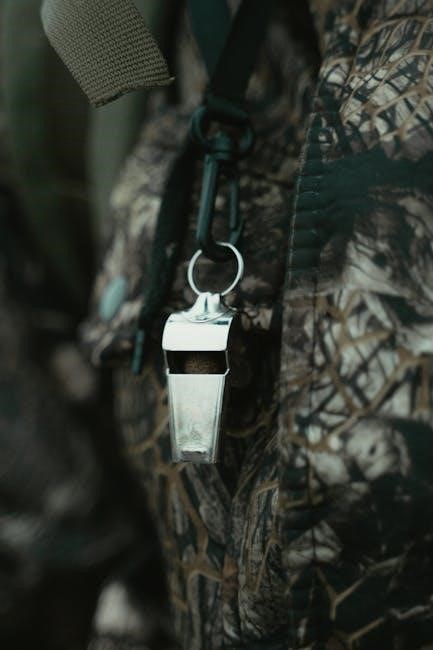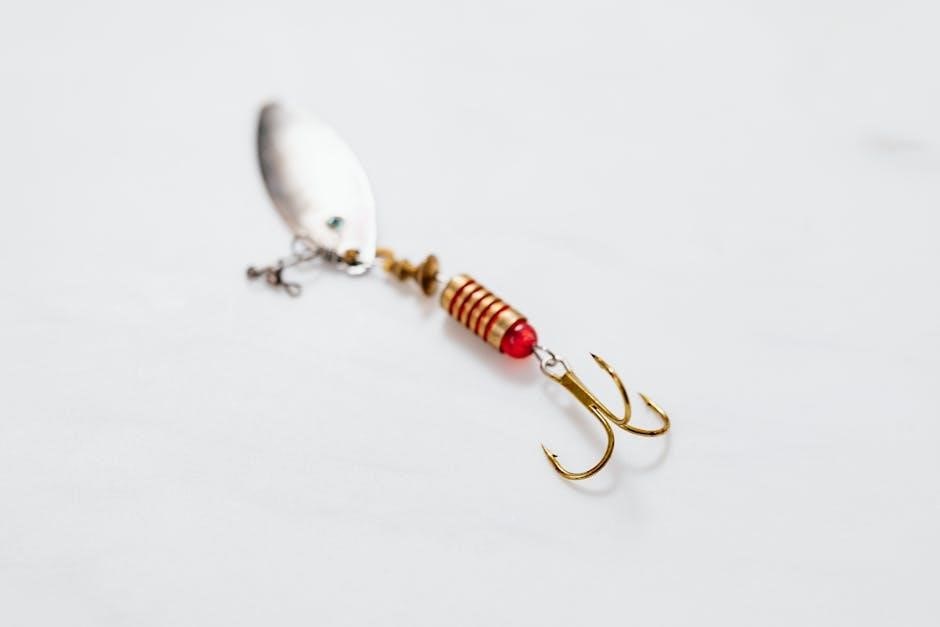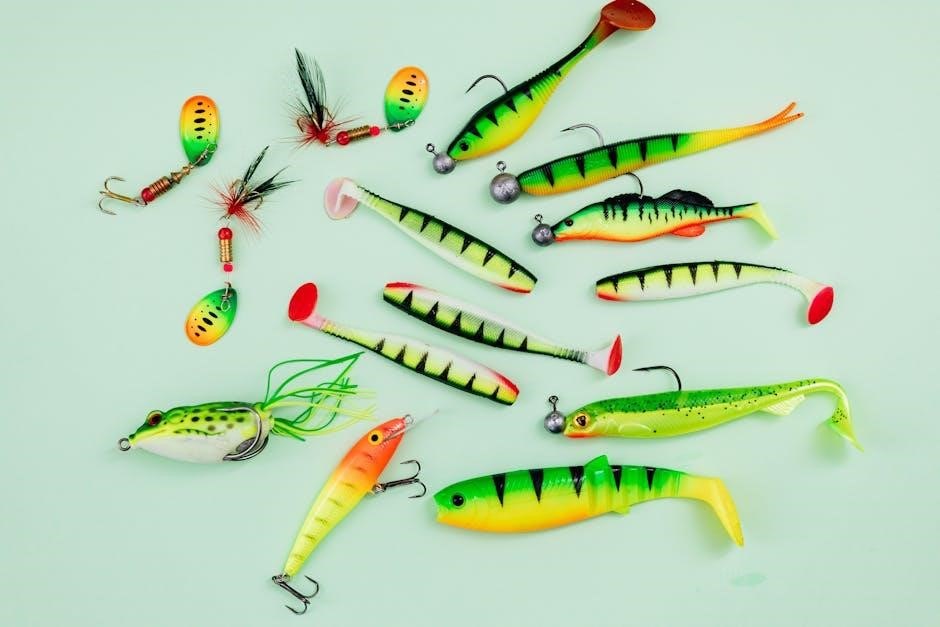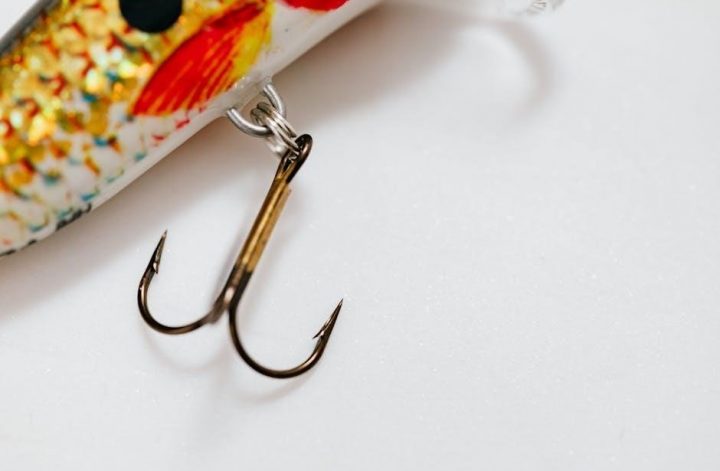Treble hooks feature three points, enhancing catch efficiency․ Ideal for lures, bait, and various fishing scenarios, they are essential for anglers targeting diverse species․
What Are Treble Hooks?
Treble hooks are fishing hooks with three points, designed to increase the chances of catching fish․ They are commonly used on lures, spoons, and bait rigs due to their effectiveness in securing bites․ Unlike single hooks, treble hooks have three sharp points, making them ideal for aggressive predators like bass and pike․ Their compact design allows for easy attachment to various fishing gear, and they are available in different sizes to suit target species and fishing conditions․ Treble hooks are a versatile option for anglers seeking reliable performance across diverse fishing scenarios and species․
Why Hook Size Matters in Fishing
Hook size is critical in fishing as it directly impacts catch efficiency and fish behavior․ Smaller hooks are ideal for small species like trout or panfish, while larger hooks suit bigger fish․ The right hook size ensures proper bait presentation and prevents fish from swallowing the hook deeply, making catch-and-release safer․ Incorrect sizes can reduce bites or damage fish․ Hook size also influences lure action; overly large hooks can hinder movement, while appropriate sizes optimize performance․ Matching hook size to target species and fishing conditions enhances success and minimizes gear damage, making it a vital factor for anglers to consider․
Understanding Treble Hook Sizes
Treble hooks vary in size, from small (12) to large (1/0), affecting their application․ Proper sizing ensures effective fishing and minimizes harm to fish․
How Hook Sizes Work: Numbers and Measurements
Treble hook sizes are categorized by numbers, with smaller numbers indicating larger hooks․ A size 6 hook is bigger than a size 12, for instance․ Hook measurements vary by manufacturer, meaning a size 6 from one brand may differ from another․ Smaller hooks (e․g․, 10-12) are ideal for small fish and delicate baits, while larger hooks (e․g․, 1/0-2/0) suit bigger fish and heavy-duty lures․ Hook weight and wire strength also influence their performance, affecting how they hold fish and interact with lures․ Proper sizing ensures effective fishing and minimizes damage to gear or fish․
Key Differences Between Hook Sizes
Treble hook sizes vary significantly, impacting their effectiveness in different fishing scenarios․ Larger hooks (e․g․, 1/0 or 2/0) are designed for bigger fish and heavy-duty lures, offering strength and durability․ Smaller hooks (e․g․, size 6-12) are better suited for smaller species and delicate presentations․ The choice of size also influences the type of fishing technique, with smaller hooks excelling in finesse fishing and larger hooks performing better in strength-based applications․ Additionally, hook sizes can vary slightly between manufacturers, making it essential to consult specific size charts for accurate selection․ This variability ensures anglers can tailor their gear to specific fishing conditions and targets․

Factors Influencing Treble Hook Size Selection
Target species size, lure type, bait presentation, and fishing conditions are key factors in selecting the right treble hook size for optimal fishing performance․
Target Species and Fish Size
Choosing the right treble hook size depends on the target species and fish size․ Larger hooks (size 6 to 2) are ideal for big, strong fish like catfish or pike, ensuring durability and secure hooksets․ Smaller hooks (size 8 to 14) work best for panfish, trout, or smaller species, allowing for precise presentation and reducing the risk of injuring the fish․ Matching the hook size to the fish’s mouth and strength ensures better catch rates and minimizes gear damage․ Proper sizing also enhances bait or lure presentation, making it more natural and appealing to the target species․
Type of Lure and Bait
The type of lure or bait used significantly influences treble hook size selection․ Smaller lures, such as finesse baits or small jigs, require smaller hooks (size 8 to 14) to avoid overwhelming the bait and ensure natural movement․ Larger lures, like spinnerbaits or spoons, often demand bigger hooks (size 6 to 2) to accommodate their size and action․ Additionally, live bait fishing may require specific hook sizes to securely hold the bait without causing damage․ Matching the hook size to the lure or bait ensures proper presentation and increases the likelihood of successful hooksets, while preventing the hook from detaching during casting or strikes․ Proper sizing enhances both functionality and effectiveness in various fishing scenarios․

Choosing the Right Treble Hook Size
Selecting the ideal treble hook size balances catching efficiency and presentation․ Smaller hooks (size 8-14) suit finesse fishing and delicate lures, preventing overwhelming the bait․ Larger hooks (size 6-2) are best for robust lures and bigger fish, ensuring secure hooksets without interfering with action․ Consider fish size, lure type, and fishing conditions to optimize your choice, enhancing both functionality and effectiveness in various angling scenarios․
Common Treble Hook Sizes and Their Uses
Treble hooks come in a range of sizes, with the most common being 6, 4, 2, and 1․ Size 6 hooks are ideal for smaller fish like panfish or trout, while larger sizes (2-1) are better suited for bigger species such as bass or catfish․ Smaller hooks (size 8-14) are great for finesse fishing and delicate lures, ensuring the bait isn’t overwhelmed․ Medium sizes (4-6) are versatile and work well for general-purpose fishing․ Larger hooks (2-1) are recommended for robust lures and heavy-duty applications․ Matching the hook size to the target species ensures effective hooksets without compromising the lure’s action or presentation․
Matching Hook Size to Fishing Conditions
Water clarity, fish behavior, and lure size significantly influence treble hook size selection․ In clear water, smaller hooks (size 6-8) are less visible, reducing spooking․ Murky conditions often require larger hooks (size 2-4) for better visibility․ Active fish may strike aggressively, allowing larger hooks, while cautious fish demand smaller, discrete options․ Lure size also plays a role—smaller lures pair with smaller hooks, while larger lures require bigger hooks․ Matching hook size to these conditions ensures effective hooksets and natural presentation, maximizing fishing success․ Proper sizing balances catch efficiency with the ability to attract and hold fish effectively in varying environments․

Treble Hook Size Chart and Manufacturer Variations
Treble hook size charts provide a standardized reference, but variations among manufacturers can affect size interpretations and performance․
Reading a Treble Hook Size Chart
A treble hook size chart is essential for understanding hook measurements and selecting the right size․ It typically lists hook sizes, corresponding lengths, and wire strengths․ Sizes range from small (e․g․, 10 or 12) for panfish to large (e․g․, 1 or 2/0) for bigger species․ Charts may include shank length, gap width, and specific features like heavy wire or forged designs․ Manufacturer variations mean size interpretations can differ slightly, so comparing charts is crucial․ For example, a size 6 from one brand might be larger than another’s․ Using these charts helps anglers match hooks to lures, bait, and target species effectively․
How Manufacturers Differ in Sizing
Manufacturers often differ in treble hook sizing due to varying interpretations of size standards․ While one brand’s size 6 may be slightly larger or smaller than another’s, the differences can impact performance․ Some manufacturers use heavy wire or forged designs, affecting strength and durability․ Others may prioritize specific features like needle eyes or black nickel finishes․ These variations mean anglers must consult manufacturer-specific charts to ensure proper sizing․ For instance, a size 6 from one brand might better suit the needs of a different species than the same size from another․ This inconsistency underscores the importance of comparing charts when selecting hooks․

Practical Applications of Treble Hook Sizes
Treble hooks are applied in various fishing techniques, from finesse fishing to heavy-duty applications․ Their size selection depends on target species, lure type, and fishing conditions to optimize performance and catch rates․
Using Treble Hooks for Specific Fishing Techniques
Treble hooks are versatile tools in various fishing methods․ In bait fishing, they allow for multiple presentations, increasing the chances of attracting fish․ For lures like spinners and spoons, treble hooks enhance the lure’s action by providing multiple hook points, which can improve catch rates․ The size of the treble hook is crucial; smaller hooks are ideal for delicate presentations in clear water, while larger hooks are better suited for aggressive species like pike or muskie․ Additionally, in trolling, larger treble hooks can withstand the force of fast-moving lures without compromising their effectiveness․ The strength and durability of the hook are equally important, ensuring reliability in different fishing conditions․ By selecting the appropriate treble hook size and type, anglers can optimize their fishing techniques for specific target species and environments․
Tips for Selecting the Optimal Treble Hook Size
When choosing a treble hook, consider the target species’ size and strength․ Smaller hooks (size 6-8) are ideal for panfish or trout, while larger hooks (size 1-4) suit bigger species like pike or muskie․ Match the hook size to the bait or lure; larger baits require larger hooks․ Be aware that hook sizes can vary between manufacturers, so refer to size charts for accuracy․ Consider the fishing conditions—strong currents or large fish may need heavier-duty hooks․ Experiment with different sizes and adjust based on performance to ensure optimal results and minimize gear loss․ Practical experience will refine your selection over time․




